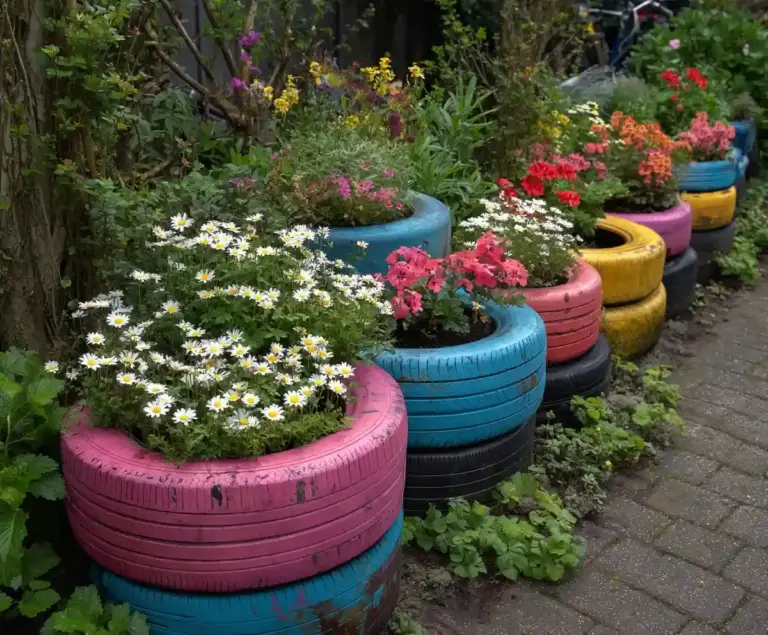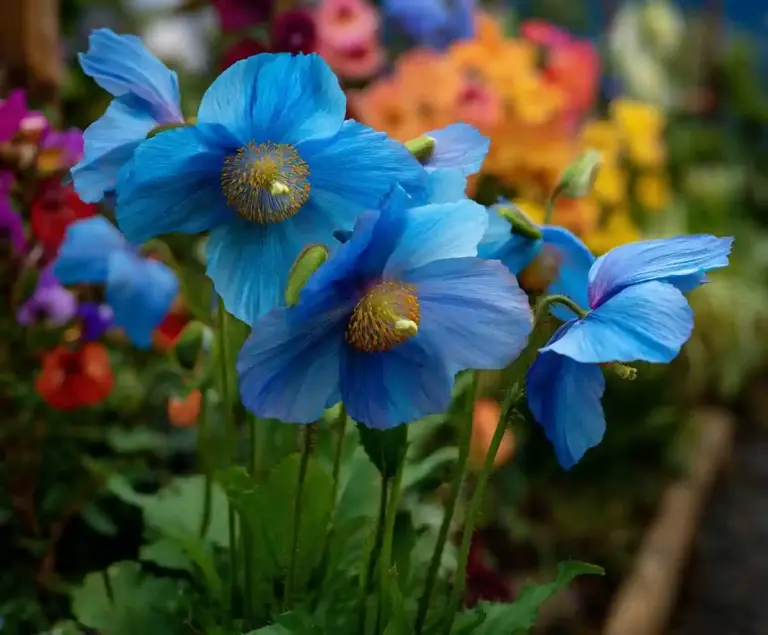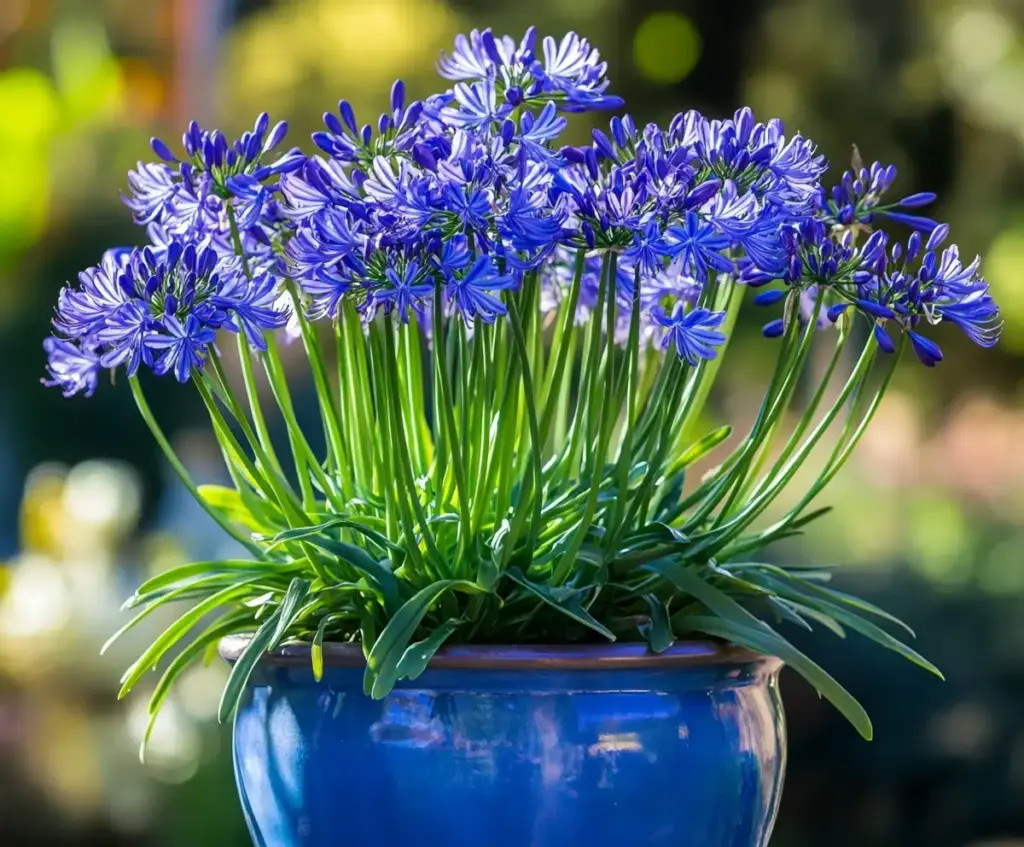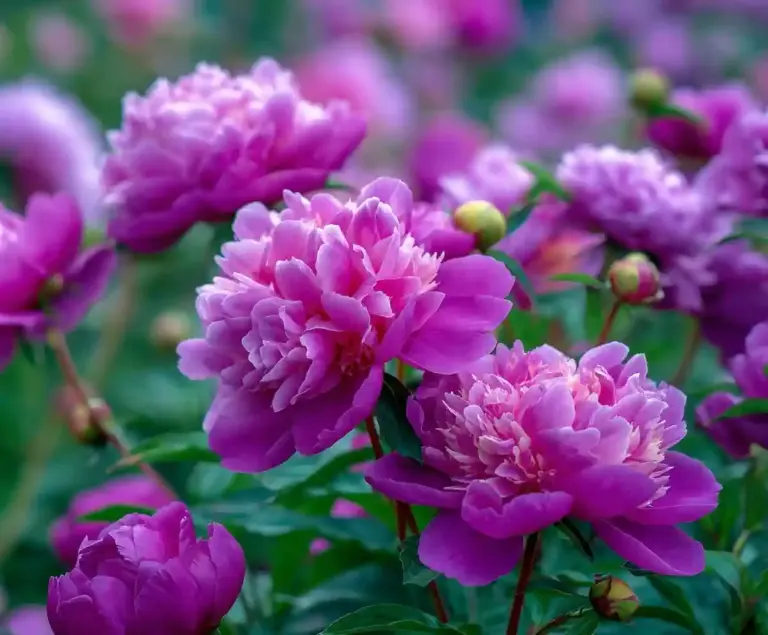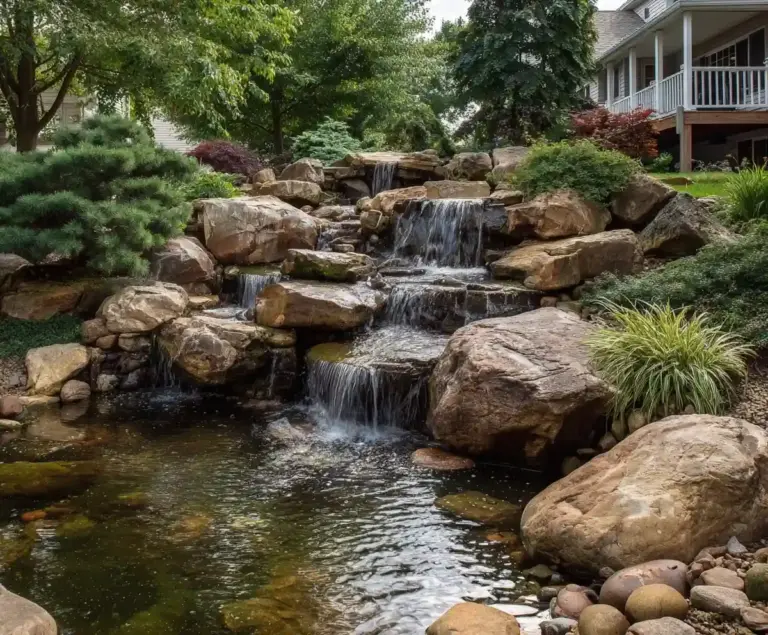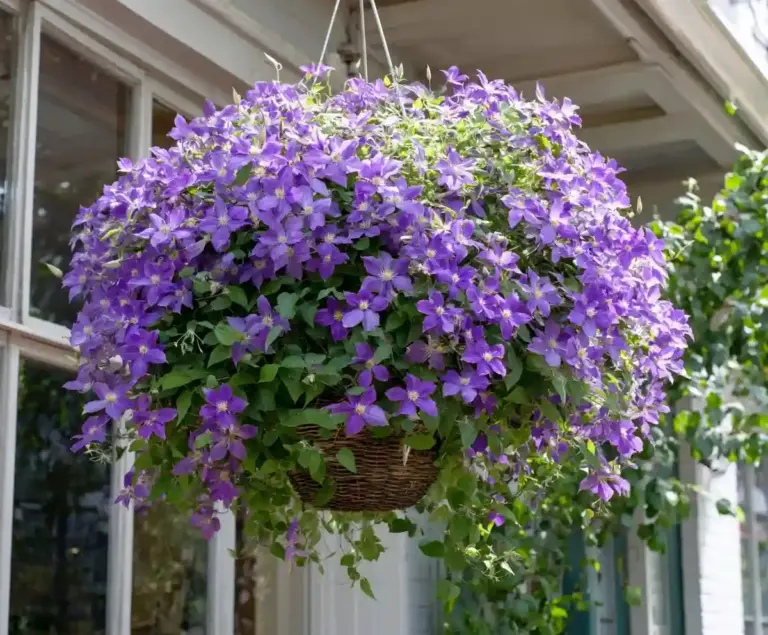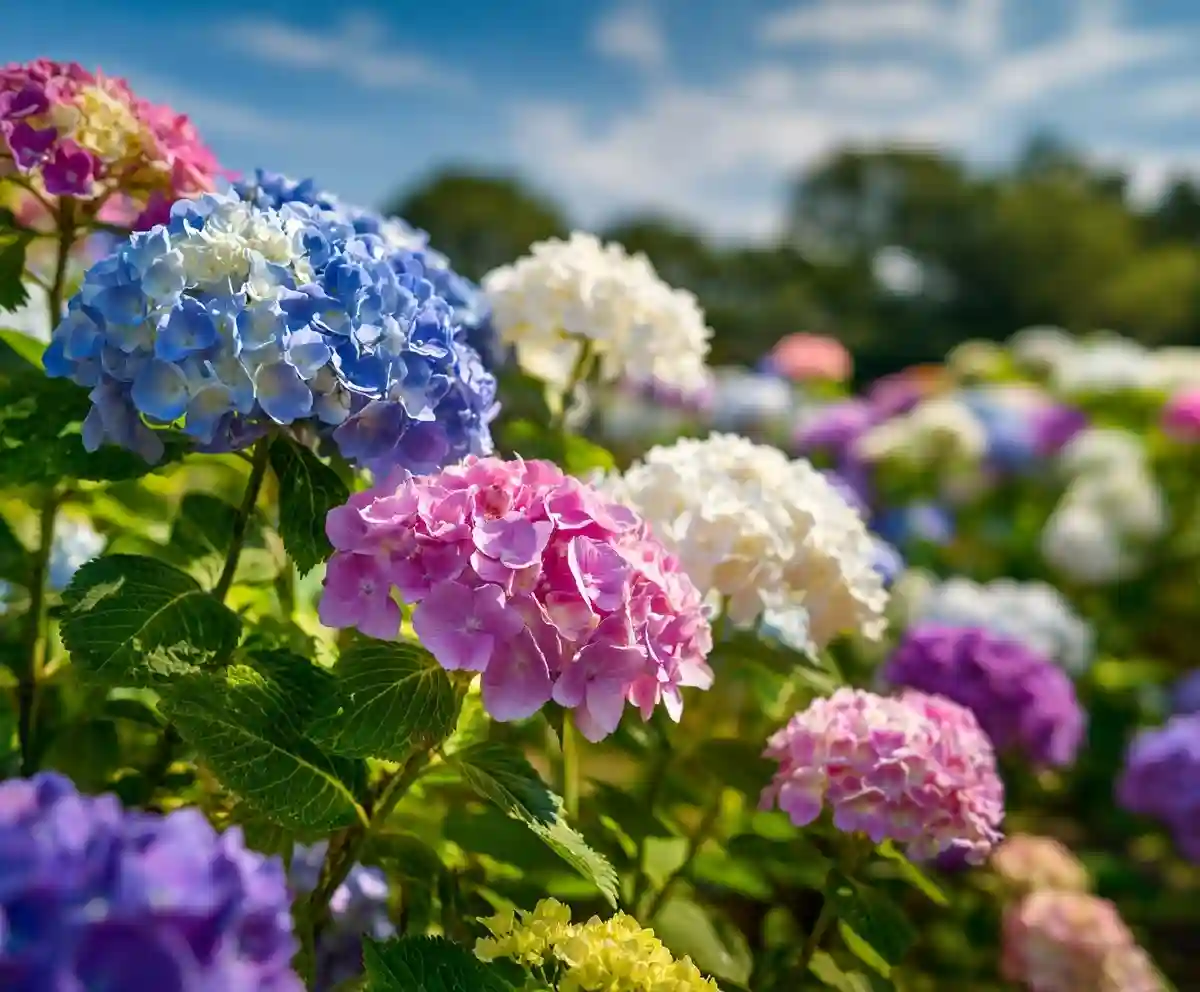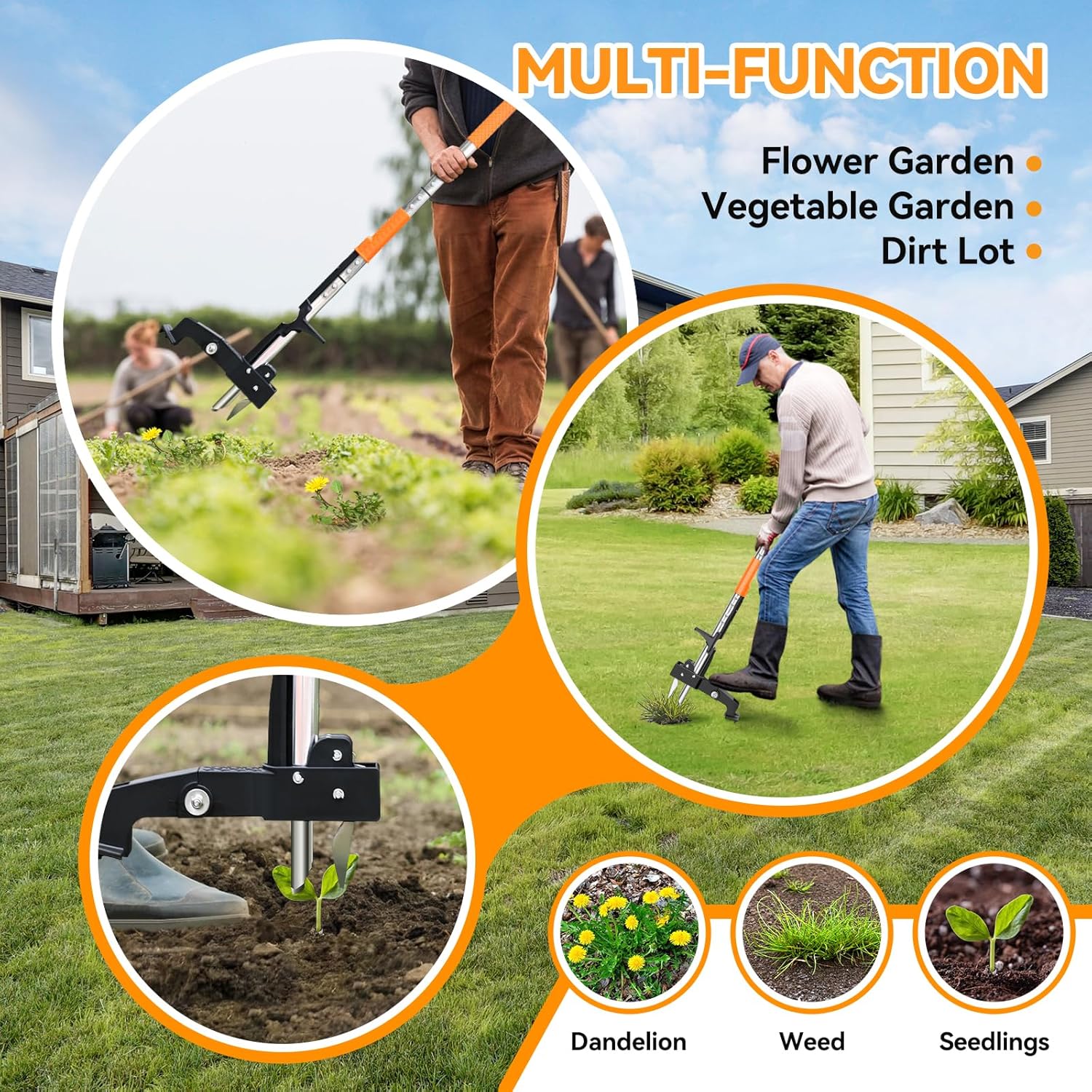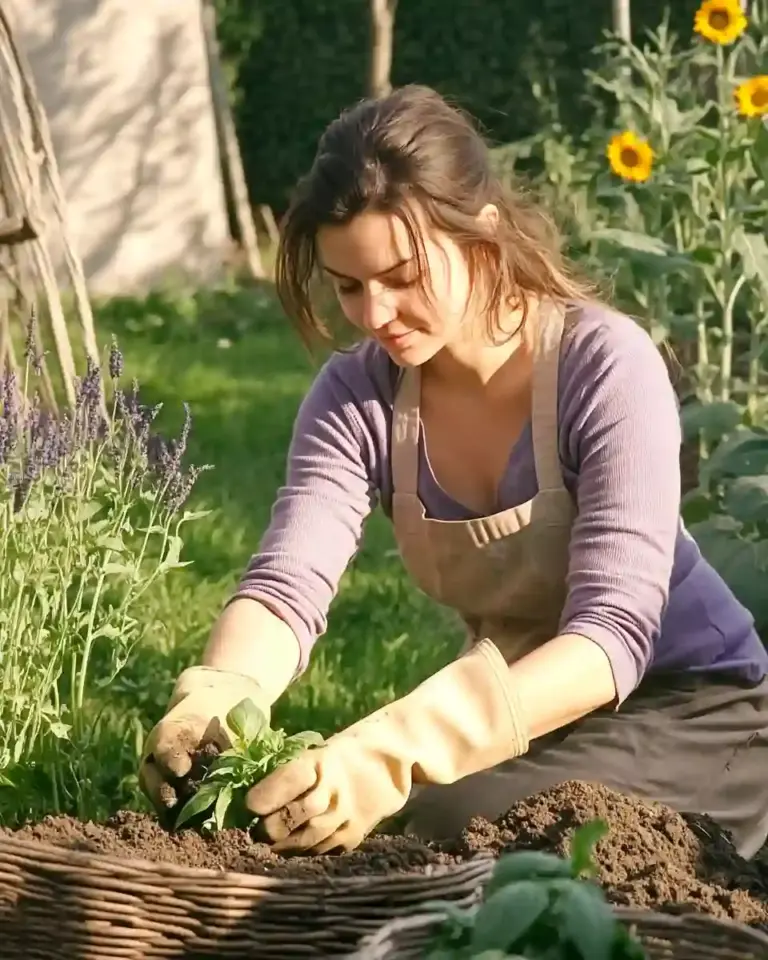Hydrangea landscaping ideas can bring vibrant color, texture, and timeless charm to any outdoor space. Whether you’re working with a small patio or a sprawling garden, hydrangeas offer unmatched versatility. Their lush blooms, ranging in hues from pastel pinks and purples to deep blues and crisp whites, can transform ordinary corners into breathtaking highlights.
Incorporating hydrangeas into your garden design isn’t just about aesthetics—it’s also a practical way to create structure, define spaces, and even attract pollinators. From neat border edges to shaded woodland beds, there’s a hydrangea solution for nearly every garden style and climate. Throughout this guide, you’ll find practical inspiration tailored to suit various spaces, sun levels, and design goals—all centered around the beauty and adaptability of hydrangeas.
Table of Contents
1. Hydrangea Border Garden
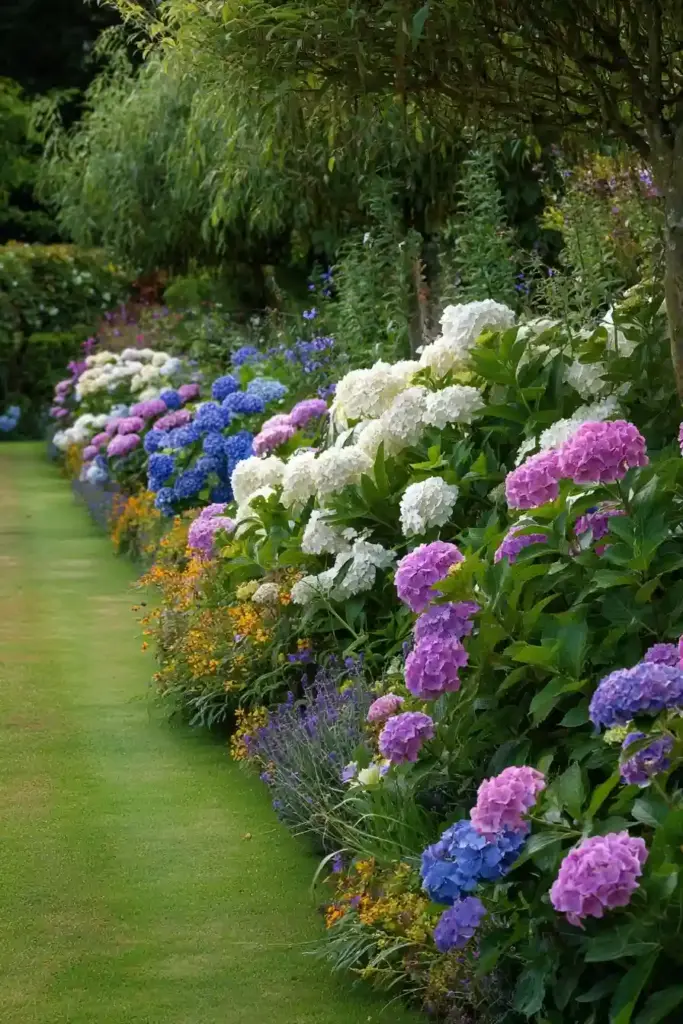
Creating a hydrangea border garden is one of the most elegant ways to frame walkways, patios, or the edge of your yard. The dense, full blooms form a natural barrier that softens hard lines while adding a burst of color from late spring through fall. This landscaping technique works particularly well when paired with brick paths, picket fences, or even mixed with lower-growing perennials like salvia or lavender.
Choose compact hydrangea varieties like Hydrangea macrophylla ‘Mini Penny’ or Hydrangea paniculata ‘Bobo’ for tighter spaces, or go bold with larger types like Limelight or Endless Summer for a dramatic effect. Stagger planting in a zigzag pattern to fill gaps and ensure consistent bloom coverage. With regular pruning and proper spacing, your border will remain lush and vibrant year after year.
2. Hydrangea and Evergreen Mix
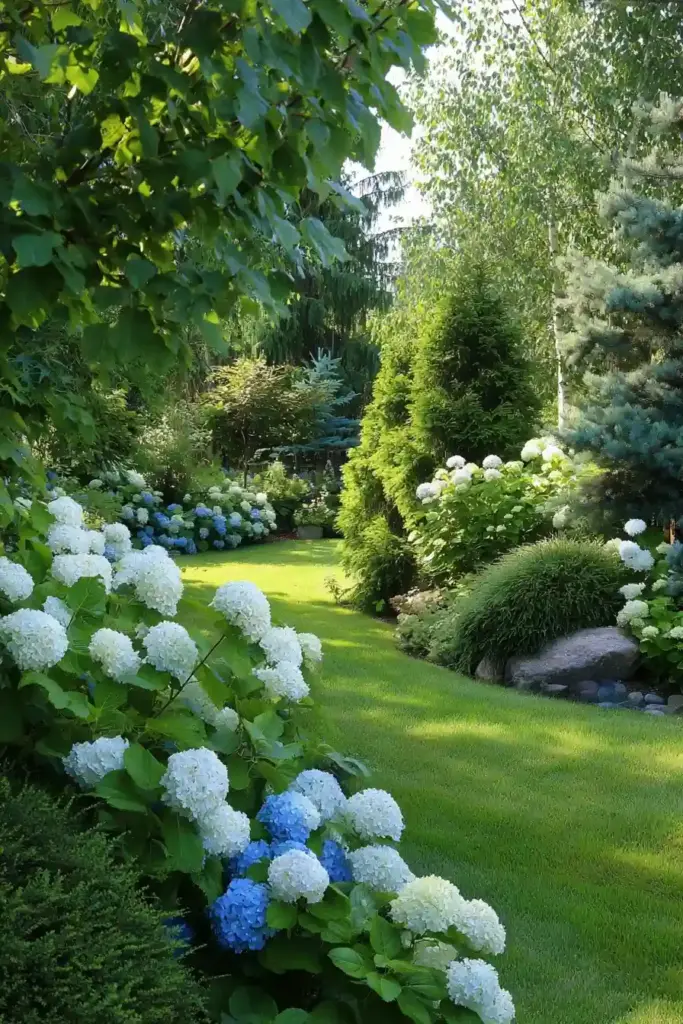
Pairing hydrangeas with evergreens creates a dynamic landscape that offers year-round appeal. While hydrangeas provide bold, seasonal blooms, evergreens deliver structure and greenery even in winter, giving your garden form and continuity when hydrangeas go dormant.
This combination works particularly well along property lines, foundation beds, or mixed borders. For balance, plant larger evergreen shrubs like boxwood, yew, or arborvitae behind the hydrangeas, allowing the flowering plants to take center stage in summer. Choose hydrangeas with a color palette that complements the rich greens of the evergreens—white or blue varieties like Annabelle or Nikko Blue create a soothing, classic look.
Not only does this mix enhance visual interest across seasons, but it also simplifies maintenance by grouping together plants with similar soil and watering needs.
3. Hydrangea Hedge
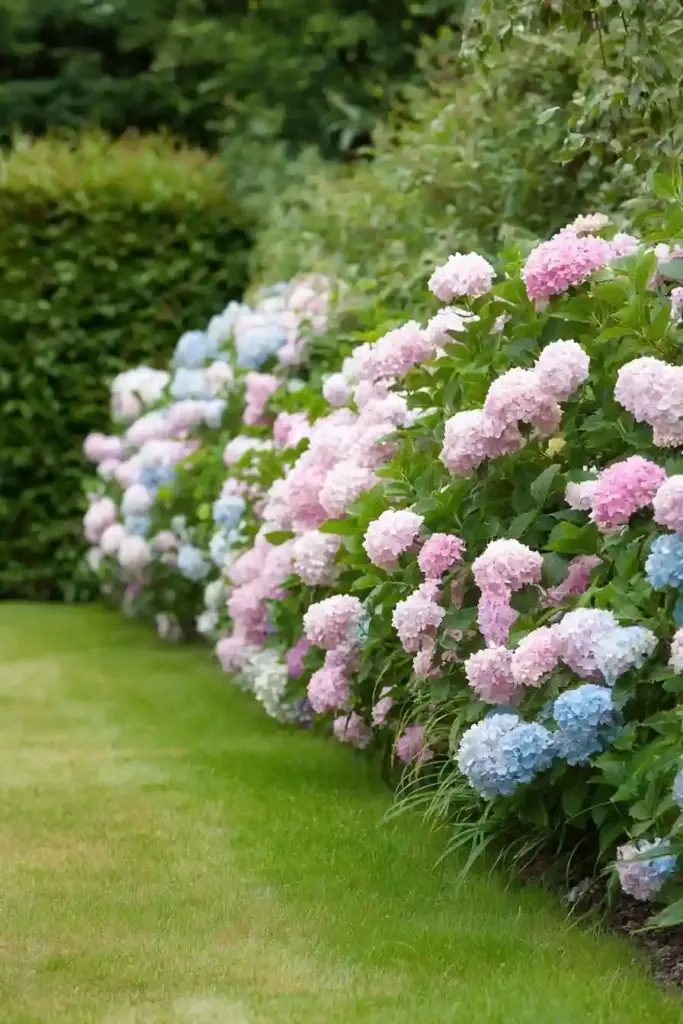
A hydrangea hedge is a beautiful and functional way to add privacy, softness, and color to your landscape. Unlike traditional evergreen hedges, hydrangeas offer seasonal interest with large, eye-catching blooms that create a living fence bursting with personality.
This landscaping idea is especially effective along property boundaries, around patios, or to divide garden zones. Choose robust, upright varieties such as Hydrangea paniculata ‘Limelight’ or *Little Lime’ for a tidy, upright form. Space plants closely—typically 3 to 4 feet apart—so they grow together into a seamless hedge. For added visual rhythm, mix in a few reblooming types like Endless Summer to extend the flowering season.
Hydrangea hedges not only enhance privacy but also attract pollinators and soften architectural lines, making them a practical and beautiful solution for many garden styles.
4. Cottage Garden with Hydrangeas
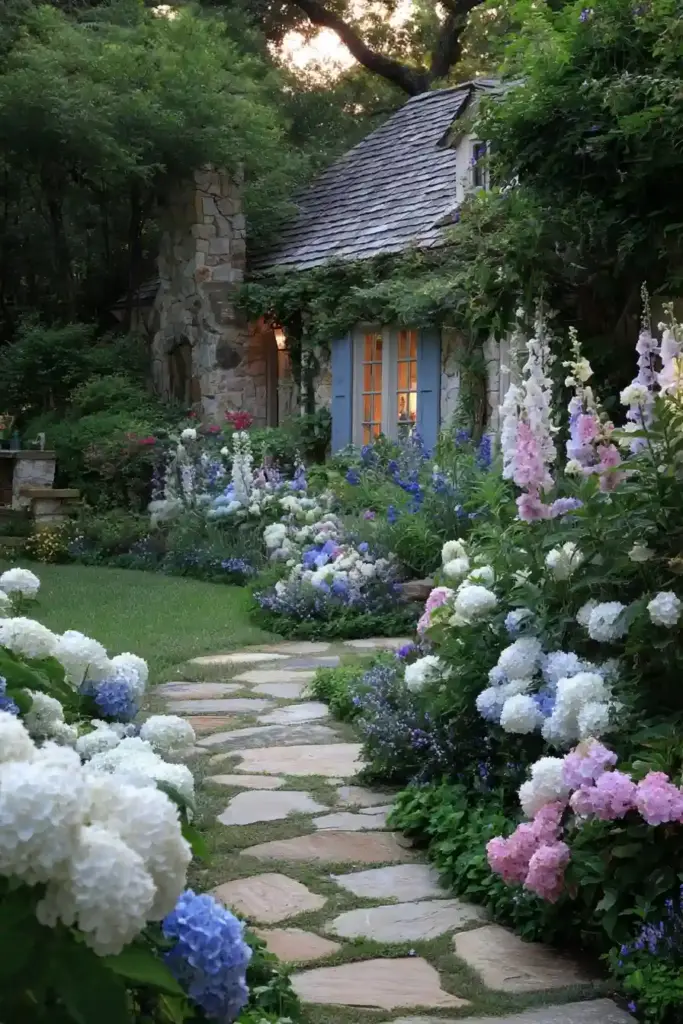
Nothing says charm quite like a cottage garden filled with hydrangeas. Their billowy blooms and soft, vintage appeal fit perfectly within this informal and romantic style. Hydrangeas blend effortlessly with other classic cottage plants like foxglove, delphinium, hollyhock, and roses, creating a lush, layered look that’s both whimsical and inviting.
To get that quintessential cottage feel, choose mophead or lacecap hydrangeas such as Hydrangea macrophylla ‘Forever & Ever’ or Hydrangea serrata. Mix them into beds with loose, overflowing arrangements, and allow them to intertwine naturally with other perennials. Vary plant heights to give the garden depth, and let self-seeding annuals like cosmos or calendula fill in the gaps.
This style thrives on abundance and imperfection, making it an ideal choice for gardeners who love a more relaxed, blooming-over-the-path aesthetic.
5. Hydrangea Woodland Garden
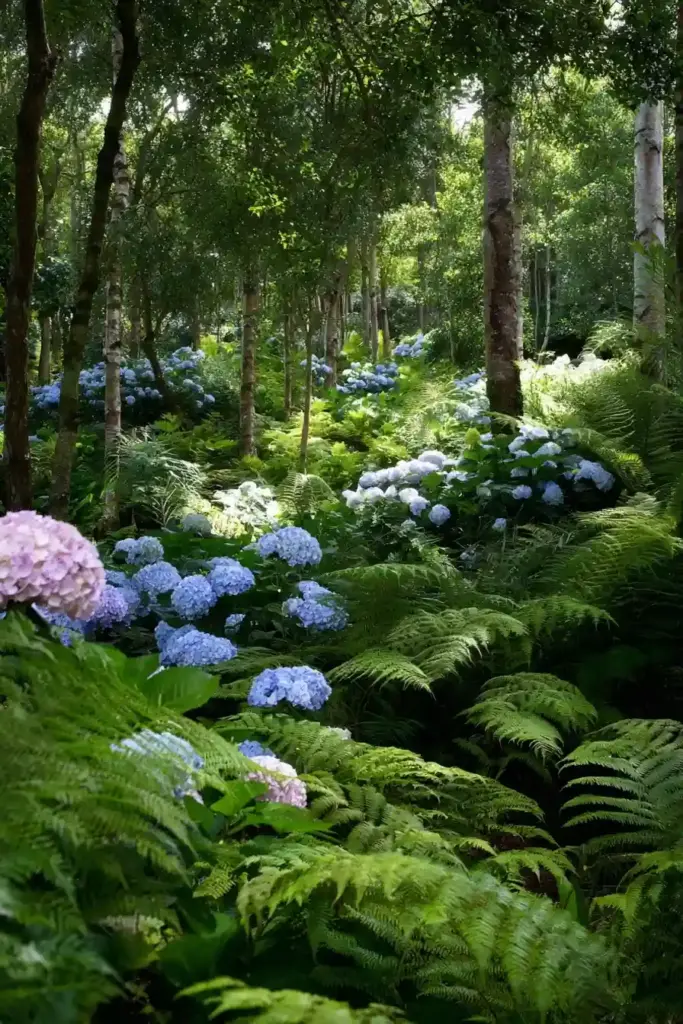
A hydrangea woodland garden transforms shaded or partially shaded spaces into serene, colorful retreats. Hydrangeas are naturally suited to dappled light and rich, moist soil, making them an excellent choice for under-canopy planting among mature trees or alongside shaded pathways.
Use varieties like Hydrangea arborescens ‘Annabelle’ or Hydrangea quercifolia (oakleaf hydrangea), which thrive in lower light and provide both floral beauty and seasonal foliage interest. Their large, textured leaves complement the delicate fronds of ferns and the broad, architectural leaves of hostas.
Layer your planting by using low-growing shade perennials in front and taller hydrangeas in the back. Mulch generously with leaf mold or bark chips to retain moisture and create that organic, woodland feel. The result is a cool, quiet garden oasis full of softness, texture, and life—even on the hottest summer days.
6. Hydrangeas Around a Gazebo
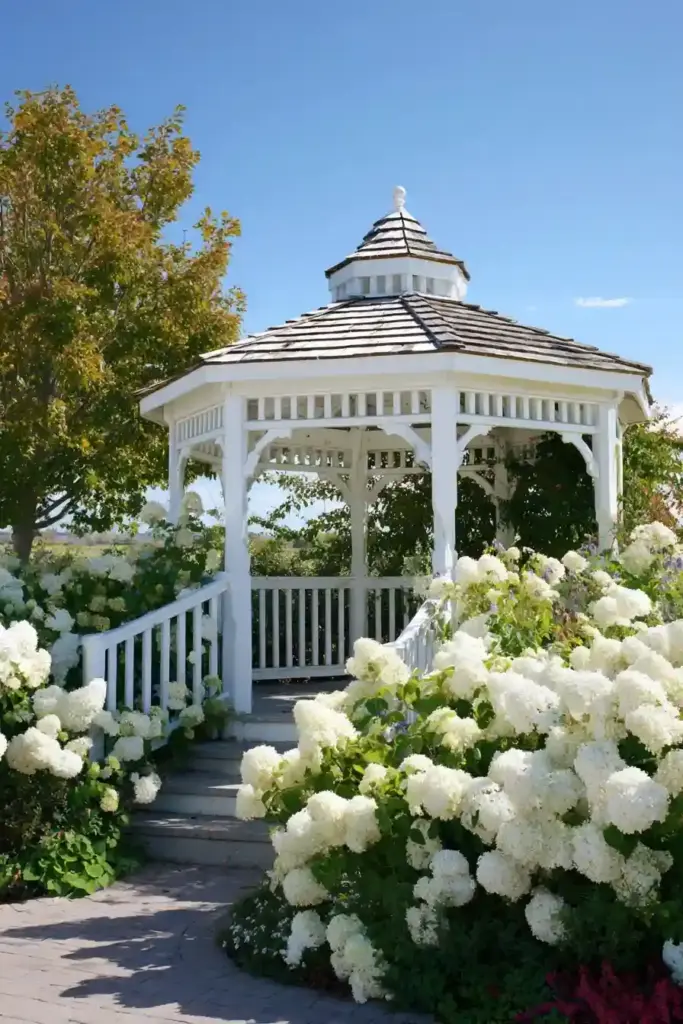
Framing a gazebo with hydrangeas creates an enchanting focal point that enhances both structure and ambiance. Their generous blooms and soft colors naturally complement the elegant lines of a garden gazebo, adding a romantic, welcoming feel to any outdoor seating area.
Start by planting taller varieties like Limelight or Vanilla Strawberry around the back and sides to provide a lush, blooming backdrop. Closer to the front, use shorter types like Bobo or Little Lime to keep sightlines open while maintaining visual cohesion. For extra texture, interplant with trailing vines or delicate shade-loving flowers like astilbe or bleeding heart.
Hydrangeas offer an ever-changing seasonal display—bright greens and blossoms in summer, fiery foliage in fall—making them ideal companions to gazebos used for relaxing, reading, or entertaining. The space becomes not just a structure, but a sanctuary surrounded by beauty.
7. Potted Hydrangeas on a Patio
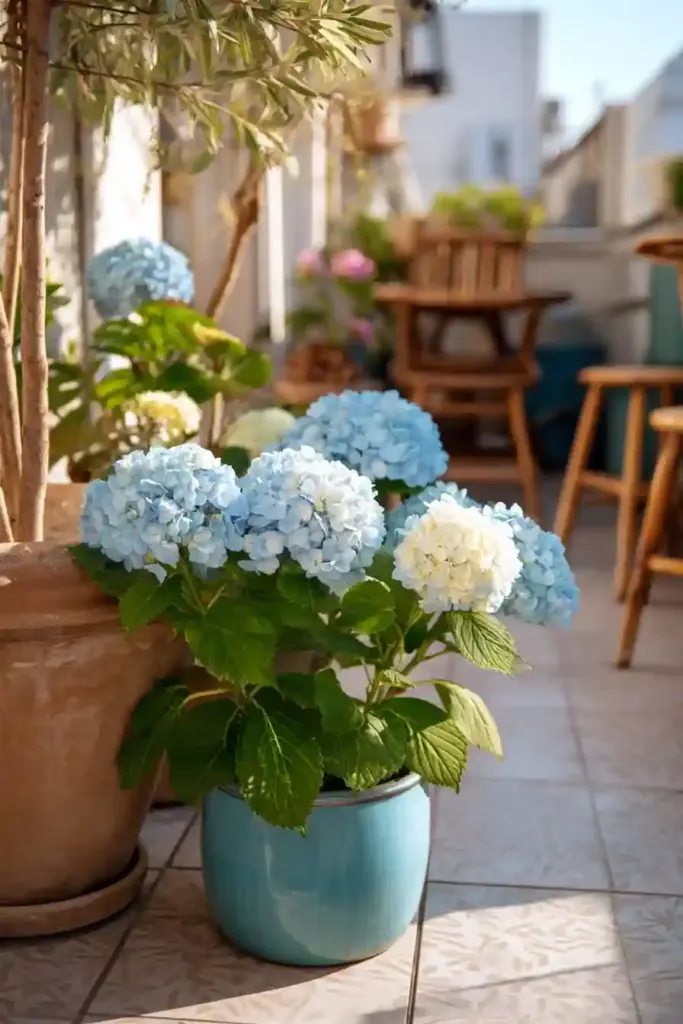
For small spaces or renters, potted hydrangeas on a patio offer a flexible and stunning way to enjoy their beauty up close. With the right container and care, hydrangeas thrive in pots and bring their iconic blooms to decks, balconies, and paved courtyards.
Choose compact or dwarf varieties like Cityline Paris, Mini Penny, or Little Lime, which are bred specifically for container gardening. Use large, well-draining pots—at least 18 inches wide—and fill them with rich, moisture-retaining soil. Keep containers in partial sun to protect the plants from excessive heat, and water regularly to prevent the soil from drying out.
Group multiple pots together for a layered effect, or flank entrances and seating areas with matching containers for a formal look. Not only do potted hydrangeas brighten up hard surfaces, but they also allow for easy repositioning and seasonal refreshes.
8. Hydrangea and Rose Combination
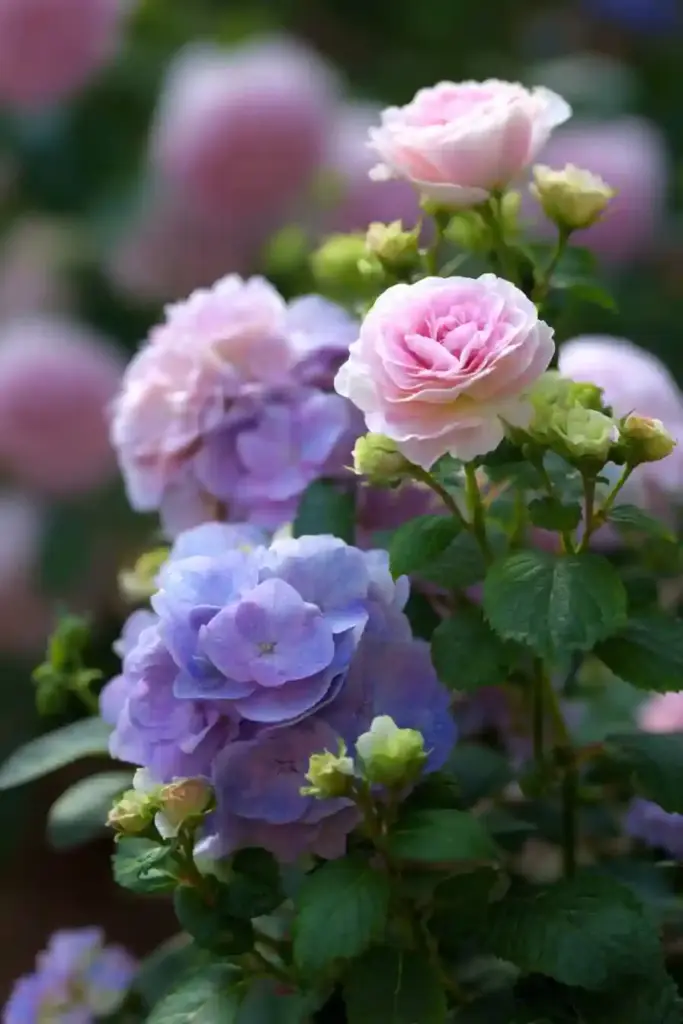
Combining hydrangeas and roses in a single planting bed brings together the best of two classic garden favorites. Hydrangeas offer large, textural blooms that contrast beautifully with the structured, elegant form of roses, creating a rich and layered landscape full of color, fragrance, and charm.
For a harmonious design, choose rose varieties with similar light and water requirements—English or shrub roses work well—and pair them with hydrangeas like Endless Summer, Zinfin Doll, or Annabelle. The hydrangeas’ softer flower heads play off the more defined petals of the roses, while their rounded shapes balance the upright growth of rose stems.
Plant in repeating groups to create rhythm, and stagger bloom times to extend visual interest throughout the growing season. This pairing works wonderfully in borders, foundation plantings, or as a centerpiece in formal garden beds, offering both drama and balance in one refined combination.
9. Hydrangea Focal Point in a Circular Bed
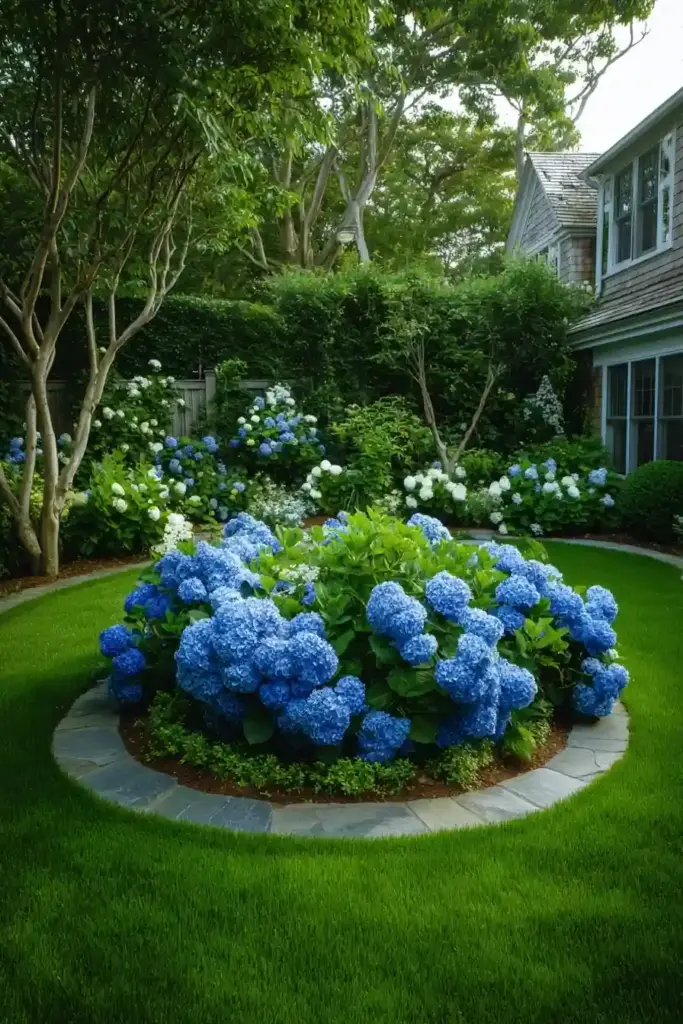
Designing a circular flower bed with hydrangeas as the centerpiece is a bold yet elegant way to create a garden focal point. The symmetrical layout draws the eye inward, while the hydrangeas provide lush, rounded blooms that naturally fit the geometry of the space.
For this design, opt for showy varieties like Limelight, Big Daddy, or Blushing Bride. Plant one or three hydrangeas at the center, depending on bed size, and surround them with a ring of contrasting plants—think salvia, dwarf boxwood, or decorative grasses—to add texture and form.
Use edging stones or low-growing groundcovers like creeping thyme to define the shape of the bed and reduce weeding. Position the bed where it can be viewed from multiple angles, such as the center of a lawn or junction of walkways. This simple, symmetrical idea turns hydrangeas into a dramatic, living sculpture at the heart of your landscape.
10. Hydrangeas Along a Fence Line
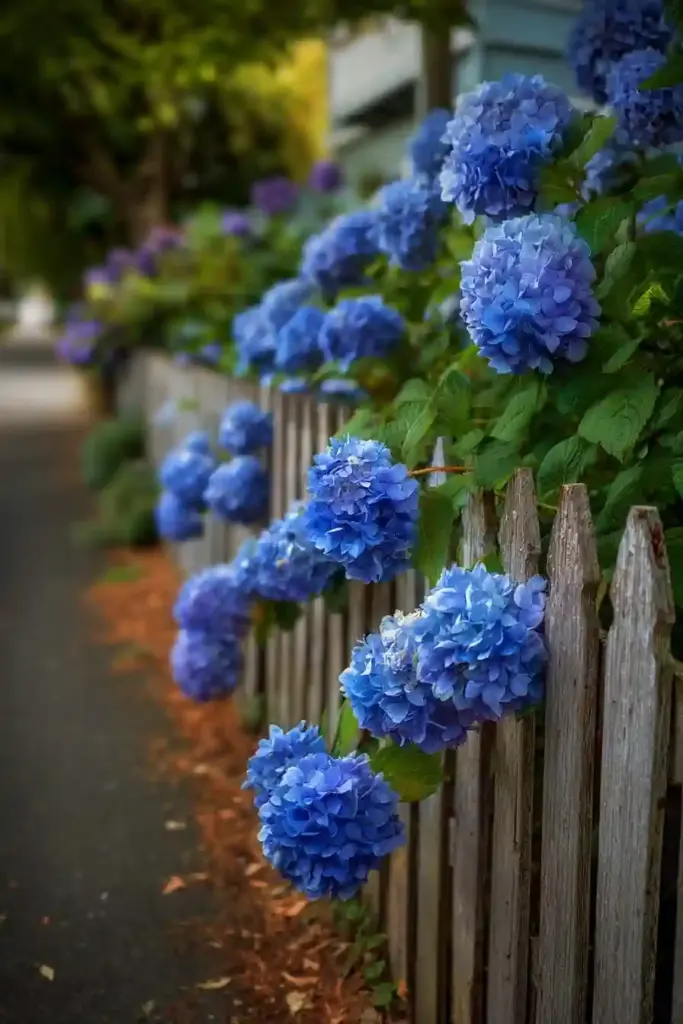
Planting hydrangeas along a fence line is a smart way to soften hard edges while adding visual depth and color. The fence provides a structured backdrop that highlights the plant’s voluminous blooms, creating a garden border that feels both intentional and full of life.
Choose upright, mid- to large-sized hydrangea varieties like Incrediball, Limelight, or Quick Fire that can grow tall enough to partially obscure or complement the fence. Space plants evenly to form a continuous row or alternate with evergreen shrubs or climbing vines for variation and year-round interest.
This layout also helps enhance privacy, especially when the hydrangeas are fully leafed out. For added texture, consider planting a lower tier of hostas, astilbe, or ornamental grasses in front of the hydrangeas. Whether your fence is wooden, metal, or even a simple trellis, hydrangeas will transform it from a utilitarian barrier into a blooming vertical canvas.
11. Hydrangea Entrance Archway
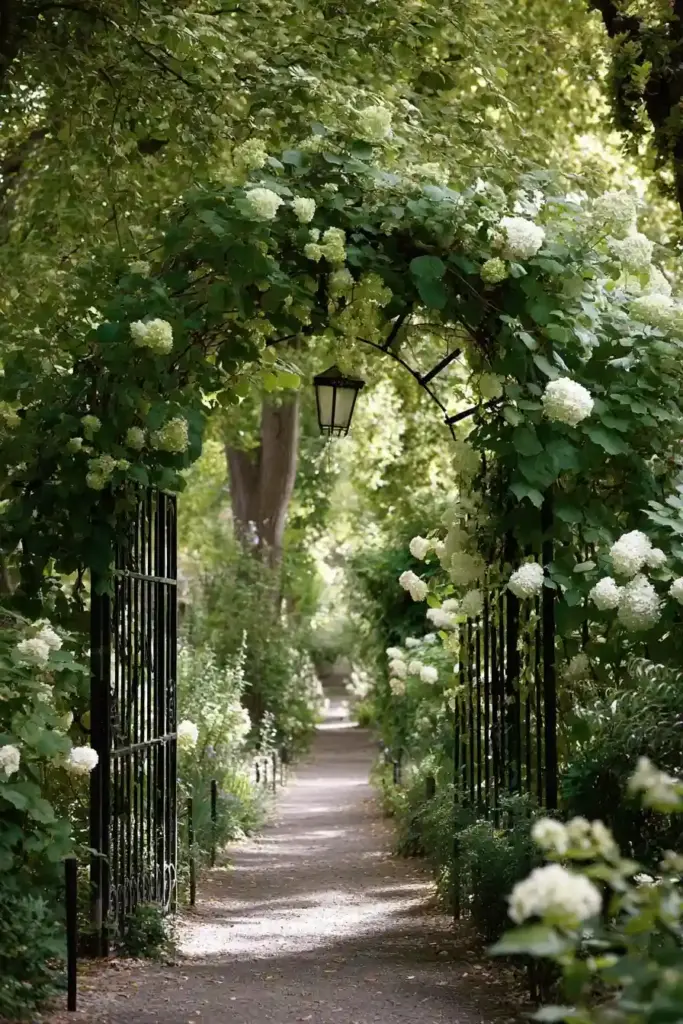
Creating a hydrangea entrance archway instantly elevates your garden’s entry point into a statement of beauty and welcome. Climbing hydrangea varieties like Hydrangea anomala subsp. petiolaris are ideal for training over arbors, trellises, or custom-built arches, where their woody vines and lacy white blooms can gracefully drape overhead.
This idea works best in partial shade, where climbing hydrangeas can slowly but steadily establish. While they’re not fast growers, their stunning appearance once mature is worth the wait. The broad green leaves and cascading flowers offer a romantic and slightly wild aesthetic, perfect for cottage-style, woodland, or formal gardens.
To keep the look clean and contained, guide young vines along supports with soft ties and prune lightly each year to encourage fullness. An archway framed with hydrangeas doesn’t just mark an entrance—it invites visitors into a space that feels thoughtful, lush, and alive.
12. Hydrangeas in a Rock Garden
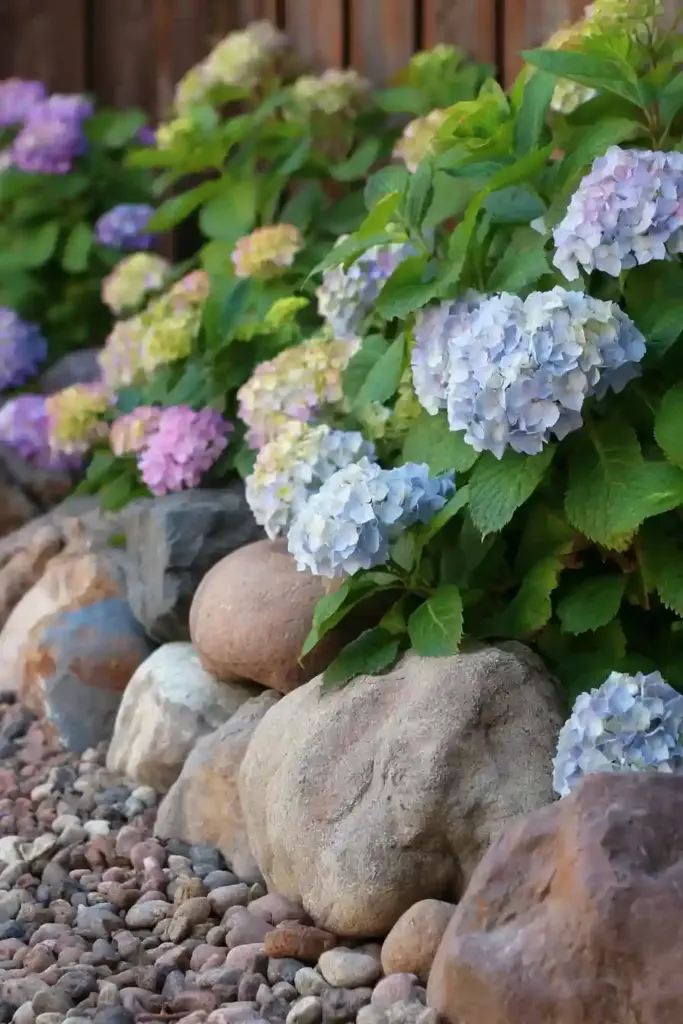
While not traditionally associated with rocky landscapes, hydrangeas in a rock garden can create a striking and unexpected visual contrast. Their lush, rounded blooms soften the rugged edges of stones and boulders, adding elegance to an otherwise minimalist or arid-looking space.
To make this pairing work, select compact and sun-tolerant varieties like Little Lime or Pinky Winky. Plant them in soil pockets between stones, ensuring good drainage while retaining enough moisture to support the hydrangeas’ needs. Add organic mulch to help regulate soil temperature and moisture levels.
The key is contrast—rich foliage against rough stone, delicate petals next to firm textures. For additional balance, include drought-tolerant companion plants like sedum, thyme, or creeping Jenny. This approach not only boosts the garden’s aesthetic appeal but also demonstrates how hydrangeas can adapt to and elevate less conventional planting environments.
13. Tiered Hydrangea Flower Bed
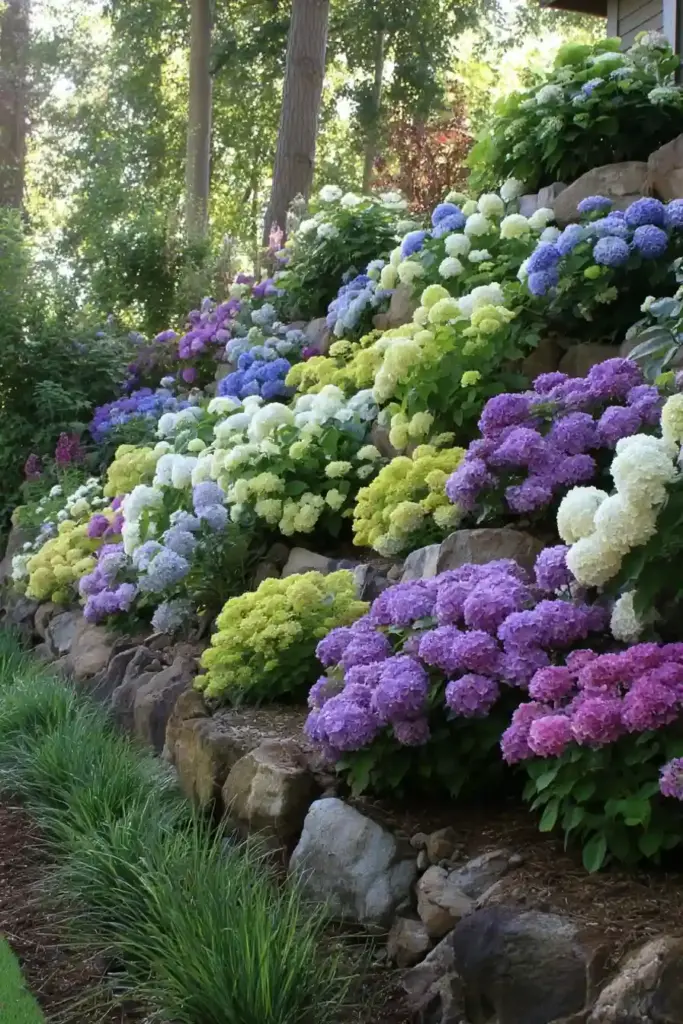
Designing a tiered flower bed with hydrangeas adds visual interest and depth to your garden by playing with height and structure. This layered arrangement allows hydrangeas to shine at multiple levels, creating a cascading effect that draws the eye upward and adds dimension to flat spaces.
Use a mix of hydrangea varieties in varying heights to build a cohesive look—taller types like Limelight or Phantom in the back tier, medium-sized ones like Endless Summer in the middle, and compact types such as Bobo in front. Each tier should be set back enough to allow plants space to grow and receive ample light and air circulation.
To enhance the tiered design, edge the beds with stone, wood, or decorative metal borders. Fill in between hydrangeas with low-maintenance groundcovers or annuals for added color and seasonal variation. This setup not only boosts curb appeal but also makes it easier to manage blooms, watering, and maintenance across the garden bed.
14. Hydrangeas Surrounding a Water Feature
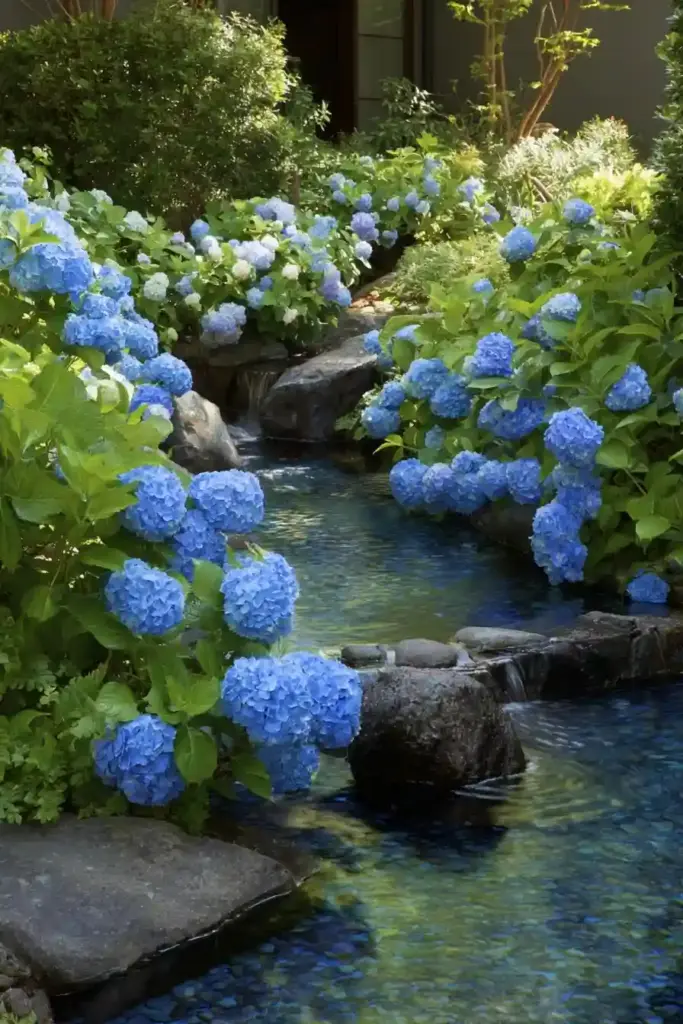
Framing a water feature with hydrangeas creates a tranquil, garden centerpiece that appeals to both the eyes and the senses. Whether it’s a pond, bubbling fountain, or birdbath, the soft, rounded blooms of hydrangeas add a romantic and reflective quality to the scene.
For best results, choose moisture-tolerant varieties like Annabelle or Blue Billow, which thrive in the slightly humid microclimate that often forms around water. Plant them just far enough from the edge to avoid root saturation, but close enough to reflect in the water’s surface and amplify their visual impact.
Pair hydrangeas with aquatic-friendly companions like Japanese iris, cardinal flower, or marsh marigold to create a layered look that blends land and water seamlessly. As the hydrangeas bloom through the summer, their reflections add depth and movement to the water feature, turning it into a serene oasis and one of the most photogenic spots in your garden.
15. Monochromatic Hydrangea Garden
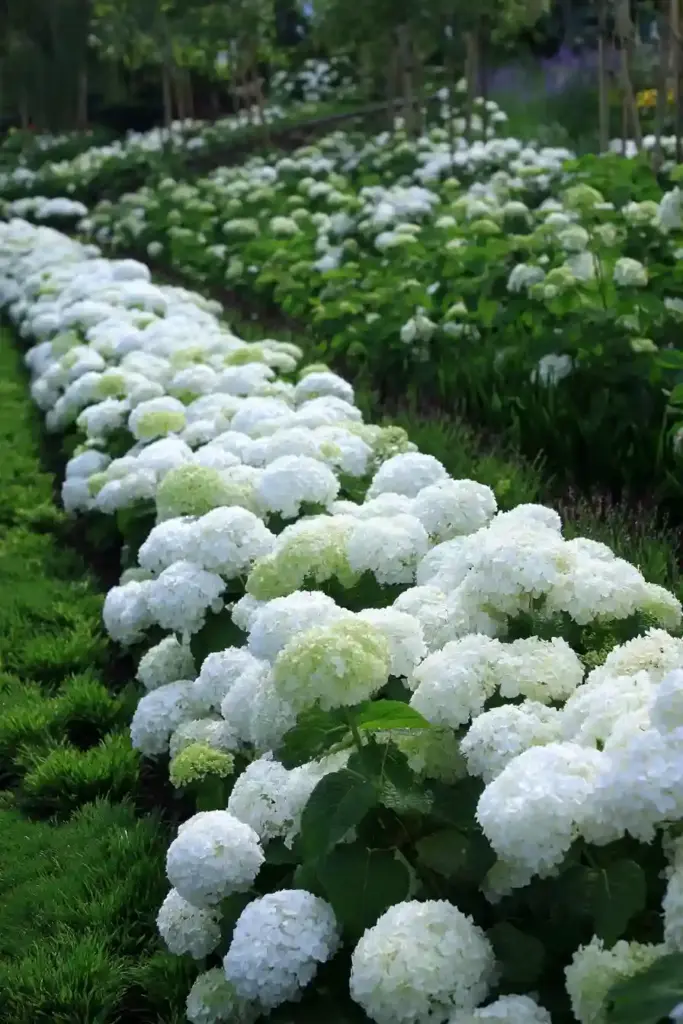
Designing a monochromatic hydrangea garden is a bold yet soothing way to make a visual statement. By selecting hydrangea varieties that bloom in the same color family—whether all blues, pinks, or whites—you create a cohesive look that feels intentional and serene.
For a blue-themed garden, try varieties like Nikko Blue or Blue Enchantress. If you love whites, Annabelle or Incrediball hydrangeas offer big, pure blooms that look especially stunning in evening light. For a pink palette, consider Invincibelle Spirit or Cityline Paris. Plant in clusters and repeat the chosen color throughout beds and borders to create a sense of rhythm and unity.
To break up the monotony without disturbing the color scheme, use a mix of leaf textures and shapes—think hostas, ferns, or silver-leaved plants. Mulch with fine bark or white gravel for added contrast and polish. The result is a garden that’s calming, sophisticated, and a true celebration of your favorite hue.
16. Hydrangeas with Ornamental Grasses
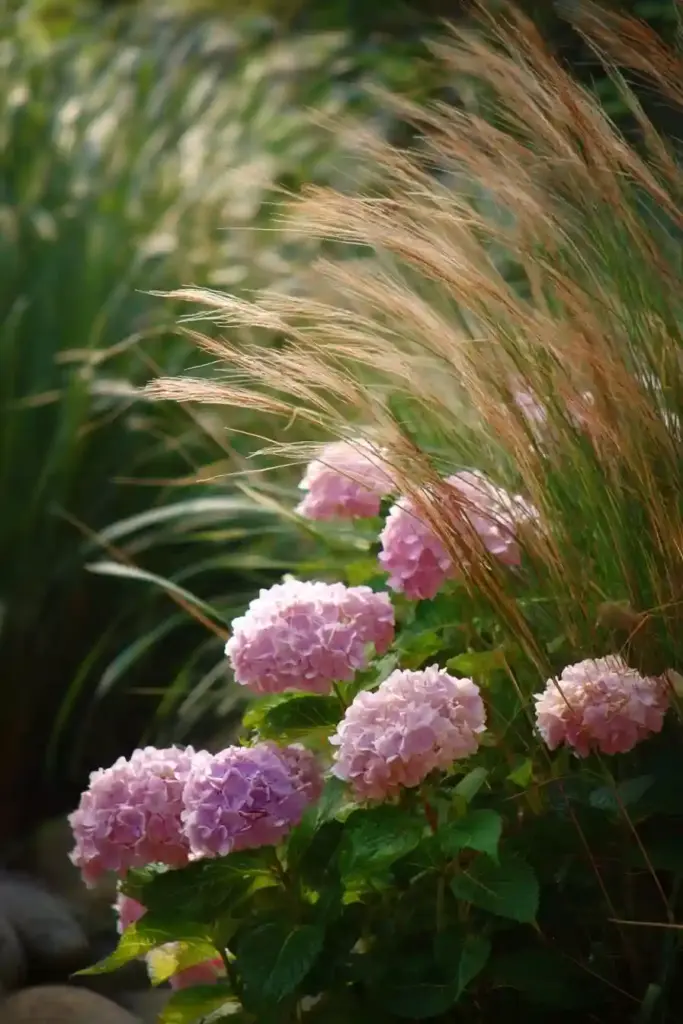
Pairing hydrangeas with ornamental grasses introduces movement, texture, and a modern flair to your landscape. The soft, swaying blades of grasses contrast beautifully with the rounded, dense clusters of hydrangea blooms, giving the garden a balanced and dynamic appearance.
Select sturdy hydrangea types like Limelight, Bobo, or Tuff Stuff for structure, and pair them with airy grasses such as Miscanthus, Pennisetum (fountain grass), or Carex. Arrange grasses behind or between hydrangeas to add height and allow their feathery plumes to catch the light and breeze.
This combination is ideal for low-maintenance gardens, as both hydrangeas and many ornamental grasses require minimal upkeep once established. It also works well in modern and naturalistic planting schemes, where the contrast of form and texture becomes the focal point. Over time, this pairing delivers year-round interest—from summer blooms to winter grass seed heads.
17. Hydrangea Island Bed in a Lawn
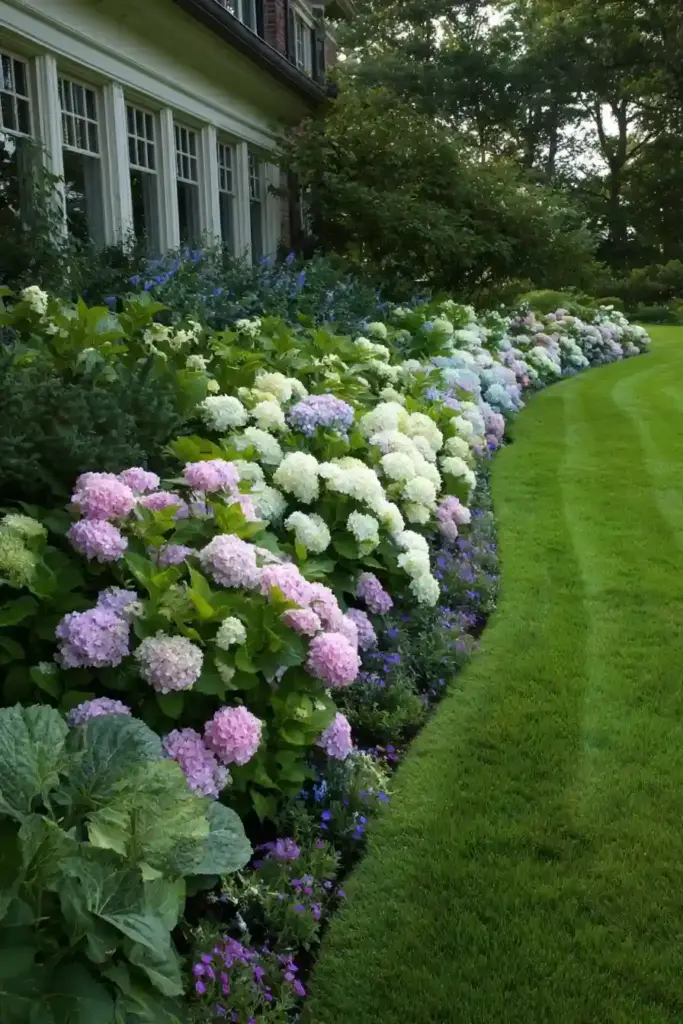
Creating a hydrangea island bed in the middle of a lawn instantly adds a striking focal point to your landscape. This approach works especially well in wide, open yards, where a cluster of hydrangeas can break up large expanses of grass and introduce color and texture right at eye level.
Begin by choosing several hydrangea varieties with complementary colors and bloom times, such as Limelight, Endless Summer, and Annabelle. Arrange the plants in a loose, informal grouping—placing the tallest hydrangeas in the center and surrounding them with smaller varieties or shade-tolerant perennials like hostas, astilbe, or brunnera.
Edge the island bed with brick, stone, or low-growing groundcovers to define its shape and keep lawn grasses at bay. As the hydrangeas grow and fill in, the bed will become a vibrant, ever-changing centerpiece—perfect for drawing attention and anchoring the design of your entire garden.
18. Hydrangeas Flanking a Pathway
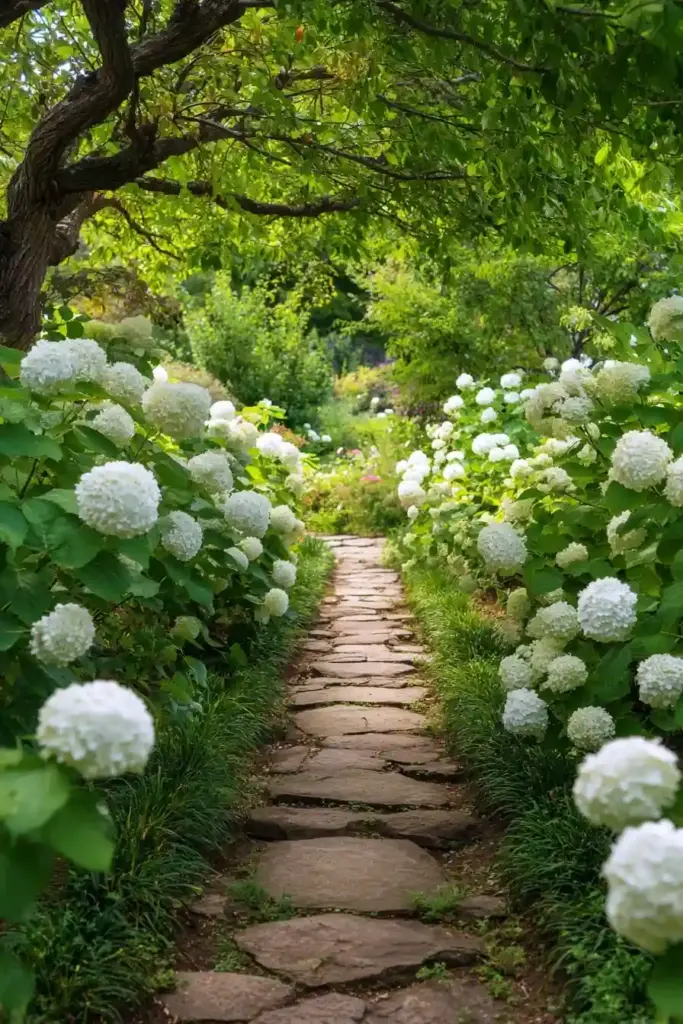
Hydrangeas flanking a pathway create a gentle sense of direction while enveloping your stroll in color and lushness. This classic landscaping idea turns an ordinary walkway into an inviting garden experience, especially when hydrangeas are planted on both sides.
Choose compact or medium-sized hydrangea varieties like Bobo, Cityline Paris, or Little Lime to avoid overcrowding the path. Plant them in evenly spaced intervals, ensuring enough room for mature growth while keeping the walkway open and accessible. For added interest, alternate with other shade-tolerant plants or use mulch and decorative stones to define the path’s edge.
Hydrangeas along a pathway provide not only beautiful blooms but also structure, guiding guests and family members toward focal points such as patios, gazebos, or garden entrances. As the seasons change, their blossoms will greet visitors with a burst of color, making each walk through your garden a delightful sensory journey.
19. Hydrangea Planter Box Under Windows
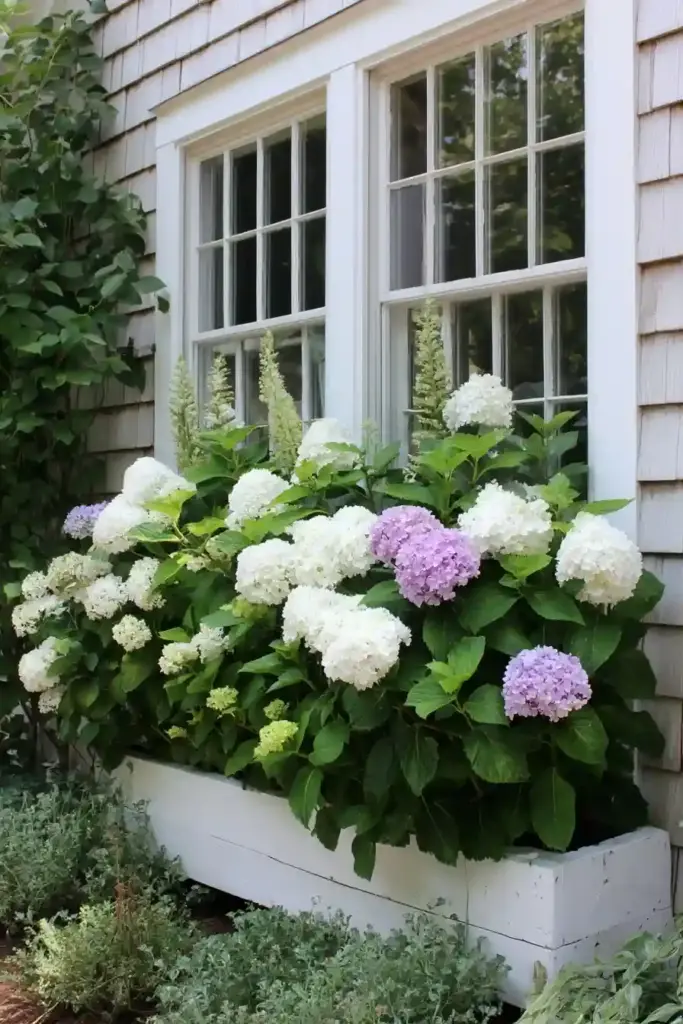
Installing a hydrangea planter box under windows is a charming way to bridge your indoor and outdoor spaces. The soft, cascading blooms of hydrangeas add a cottage-like appeal, framing windows with color and greenery while bringing the garden’s beauty closer to your living areas.
Choose dwarf or compact hydrangea varieties such as Mini Penny, Cityline Rio, or Little Lime—these fit nicely in window boxes or larger trough planters without overwhelming the space. Make sure your containers have good drainage and fill them with moisture-retentive, rich soil to support healthy growth.
Place planter boxes where they’ll receive morning sun and afternoon shade, which most hydrangeas prefer. Mix in trailing plants like ivy, sweet potato vine, or bacopa for added interest and softness. This setup not only brightens up window views but also attracts pollinators right up to your home, blending garden delight with everyday living.
20. Hydrangeas Paired with Perennials like Hostas and Ferns
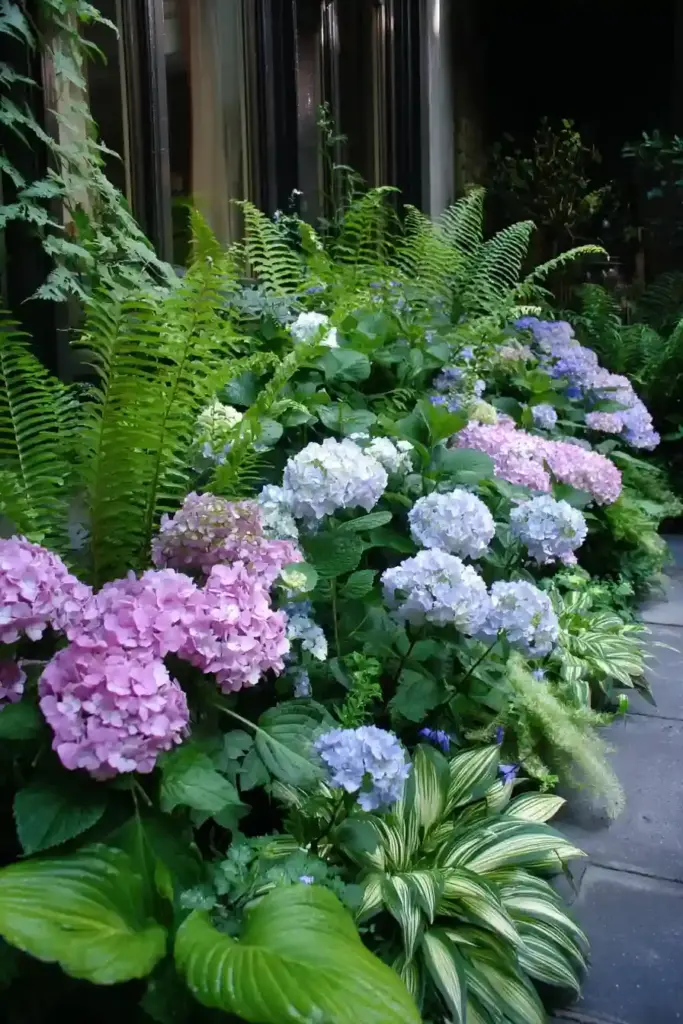
Pairing hydrangeas with perennials like hostas and ferns creates a lush, layered garden bed that thrives in shade or partial sun. This combination is perfect for areas beneath trees, along the north side of your home, or anywhere you want a rich, woodland effect.
The large, vibrant blooms of hydrangeas stand out against the broad, architectural leaves of hostas and the feathery, delicate fronds of ferns. Together, these plants offer a pleasing contrast in color and texture—hydrangeas provide boldness and height, while hostas and ferns fill in the lower layers and add movement.
Choose hydrangea types suited for shadier spots, such as Hydrangea arborescens ‘Annabelle’ or Hydrangea quercifolia (oakleaf hydrangea). Plant hostas and ferns in front or between hydrangeas, letting them spill over borders for a soft, natural look. This trio is not only visually appealing but also low-maintenance, as all three plants enjoy similar moisture and soil conditions.
author:Conclusion
Hydrangea landscaping ideas offer a world of possibilities for gardeners of every skill level and style. From classic borders and elegant hedges to creative container displays and woodland retreats, hydrangeas can be the star of your garden or a perfect partner to other beloved plants. Their adaptability to different light conditions and garden settings makes them a top choice for adding structure, color, and seasonal beauty.
By thoughtfully pairing hydrangeas with evergreens, ornamental grasses, or shade-loving perennials, you can design a garden that shines from early summer through fall—and sometimes even into winter. With the right care and placement, hydrangeas will reward you with year after year of spectacular blooms and garden enjoyment.
🌿 Love gardening inspiration? Follow me on Pinterest for bold plant ideas, tips, and seasonal color!
More Posts
